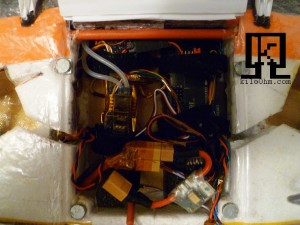The Autopilot system includes the IMU (compass), GPS, airspeed sensor, temperature and barometer sensors as well as other sensors. The radio receiver’s signals are routed to the autopilot where sensor considerations are made and then data is outputted to the servos and speed controllers. It is responsible for the full automation of the whole system in modes such as “circle” or partial automation in modes such as “stabilize”.
The on screen display (OSD) is technically part of the video system, however more often now it is embedded into the autopilot. The OSD is data that overlays your video with speed, altitude and battery usage amongst other features. An OSD is a piece of hardware that fits between the camera composite output and the video transmitter input or some of them feature the OSD as part of the autopilot, which results in ease and lightness.
Autopilots have onboard gyro stabilization that keep things level and remove unwanted movement and compensate for turbulence, more or less. Gyros can be purchased without autopilots, in the form of flight controllers. Two applications for a gyro:
Aileron / Elevator Stabilization – Connect a gyro to the servos on the control surfaces of your aircraft, it will actively fight the wind that batters the ailerons. Your plane will be much more stable while flying in winds. This is particularly important when using a “return to home” system because sometimes it’s easier for the plane to fly its self.
Camera Stabilization – When using a “gimbal” mount for your main camera it will remove some shake that the wind brings. Necessary to achieve professional smooth video. There are brushless gimbals (EvvGC) will give your smoother operation but may cost more than a servo operated gimbal.
Here are some top gun Autopilots. There are about several different makes on the market, it can be daunting, I will discuss the three most popular for fixed wing.
3D Robotics ArduPilot APM 2.5 / 2.6 – A popular full featured autopilot that can put used on planes, quads or ground vehicles. Open Source Arduino based. Telemetry can be added; 3D Robotics 900MHz 100mW but you won’t get far on that without a booster. Ground station software is available and free. Large forum community. Requires current sensor minimOSD and GPS UBlox-6 and optional airspeed kit. $75-300 total depending on origin. Beware of poor clones out there. V2.6 includes an external compass (magnetometer) so it can be placed away from motors.
3D Robotics PX4 (Pixhawk) – New successor to the APM, features a faster 32bit processor and more memory. With this you can also run a gimbal control onboard. Uses Qgroundcontrol software.
uThere Ruby – Like the APM this has auto take off, assisted flight/fly by wire, loiter, autonomous landing, panic mode/RTH. Comes with its own GPS, current sensor, barometer, airspeed, and magnetometer. The OSD is an add-on module (RubyOSD) – $140. Under development is a new ground control software with way-point generation for PC and two way 900MHz telemetry at 250mW and a 750mW! This could make for a complete robotic long range UAS. Weighs 30g, $345 + optional OSD & telemetry systems.
Others that have autopilot functions: Eagletree OSD, Dragon OSD, Paparazzi, Rangevideo RVOSD
Others that have autopilot functions for copters only: DJI Naza, VR Brain, Openpilot, Crius AIOP – MegapirateNG
‘Flight Control’ boards for copters: These are ‘dumb’ in that they don’t have waypoint control or other advanced features. They are made for general stabilization of quadcopters. This is mentioned because they can be directly replaced by a full autopilot and are often called autopilots, although they are not. They are often really inexpensive and are a great way to control a RC quad, $10. Examples: KK2.x or MultiWii
Add-on OSD, no autopilot included. – An OSD is device that interfaces with your video transmitter and overlays HUD information, like speed and altitude or a hundred other items that you want to see on your LCD monitor at base camp. Some like EzOSD have their own sensors like GPS and accelerometers to provide the data, others like MinimOSD don’t have sensors and rely on the autopilot for that information via the MAVLink protocol. OSD’s won’t have automation like waypoints.
EzOSD – An add-on OSD with GPS, Current sensors and other sensors. Has one way audio channel telemetry downlink with iPhone and Android apps. Next best thing to an autopilot and its easy. $180
MinimOSD – An inexpensive OSD made for Ardupilot, $40 for the original $15 for the clones. Lots of guys burn them up because the units can’t handle the 12 volts. Wiring is not straight forward, it has a 12V input, but do not apply 12V to it, just apply 5V. Look in my schematics section of the APM plane for correct wiring. And follow my firmware upgrade to Extra here.
A note on Return to Home (RTH) – It can’t compensate for broken physical parts such as ailerons, stuck servos or other malfunctions. Do not rely on RTH to work use only if you lose video feed or when you deem it an emergency.



